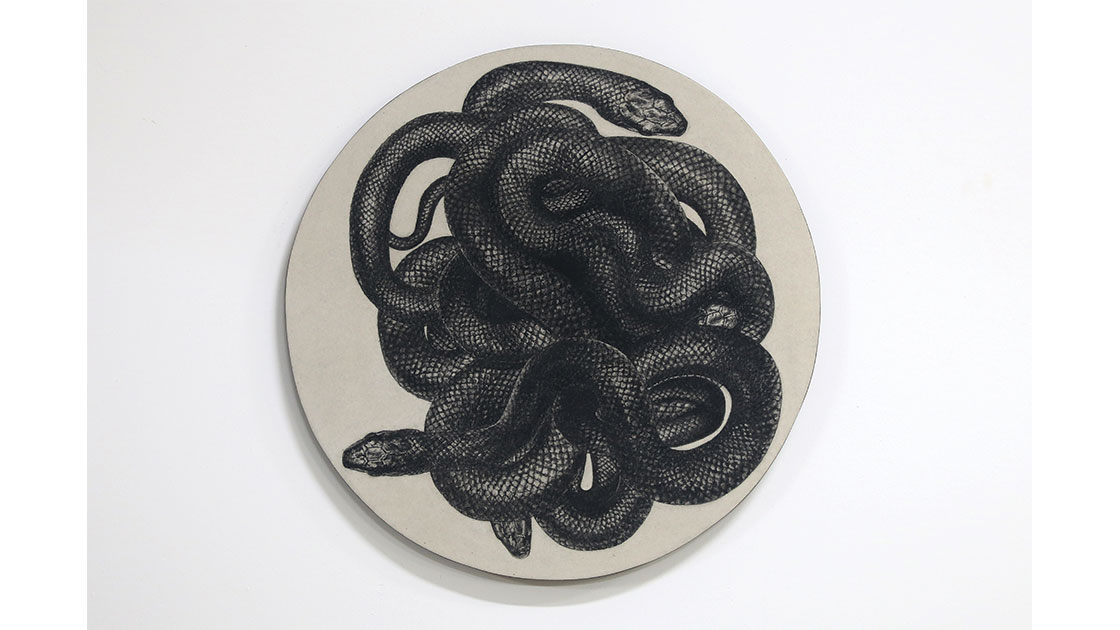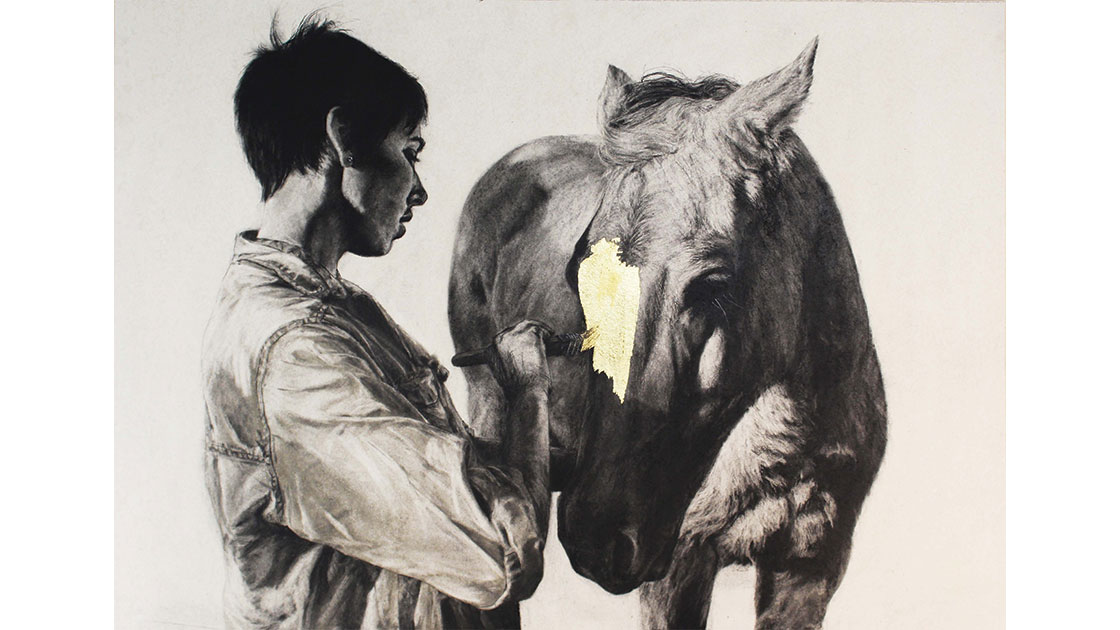Anna Louise Richardson
Everyday dangers are larger-than-life in Anna Louise Richardson’s new exhibition at Galerie pompom. Incarnations of fear encountered while raising small children on a cattle farm, the objects tell a story of the artist’s life in a rural setting. a knife, power cords, poison; the objects also tap into a shared sense fear in the face of our own mortality.
Anna Louise Richardson’s charcoal and graphite drawings are luscious and dramatic. Her subject matter can be confronting: a hanging carcass, an oversized fly, amplified by the depth and tone of her drawings. Muscle is glossy; hairs are defined. Ideas
of our human relationship with the natural world are pushed into the spectators’ sphere, with a flattened perspective that homes in on intricate details and emphatically lays out the frankness of an existence shared with other species, everyday dangers, and the inevitably of death. Derived from Richardson’s own experiences of life on a cattle farm in south-west Western Australia, the artist’s latest works share new revelations of rural life: raising children on a farm.
Familiar and domestic objects feature in Richardson’s exhibition ‘We should be more afraid of the sun than the moon,’ showing at Sydney’s Galerie pompom as part of Art Month this March. The exhibition presents a series of oversized cut-out drawings of everyday objects, ranging from power cords to poison. They are objects of danger, incarnations of parental worry. Knife (2019) depicts a giant kitchen knife, as tall as a person, hanging point-to-floor, while Crash (2019) represents the dismembered door of a wrecked car. Embodying everyday disquiet, the works provoke imaginings of calamities on a domestic scale.
These depicted objects are salient to Richardson’s life as a mother of young children on a cattle farm. Her daughters, two-year-old Aziza and infant Althea, who she raises with husband and fellow artist Abdul-Rahman Abdullah, are the seventh generation of her family on the farm. Touching on the complex emotions and responsibilities of multigenerational farming, Richardson’s work emphasises how relationships to place and nature can be shaped through different histories, storytelling and imagination.
The complexities of our human relationships with the natural world and the intergenerational qualities of these relationships are driving themes throughout Richardson’s practice. Last year the artist completed Aziza’s Zodiac (2018-19), a 12-panel artwork featuring one animal for every month of a year after the birth of her daughter, Aziza. The work, a year-long project created for an exhibition at Fremantle Arts Centre, Perth, reflected her daughter’s life, told through the animals around her. It serves as a record of her daughter’s personal history on the farm, and responds to Richardson’s own evolving narrative of motherhood.
Working in charcoal and graphite on cement fibreboard, Richardson’s drawings are both gritty and realistic. ‘I love the depth, softness, tone and grubbiness of charcoal,’ says the artist. The monochromatic consistency of this material lends an overarching moodiness to her works, which can be as edgy in aesthetic as they are in the rawness of their content. In cohesion with a sense of rural pragmatism, Richardson’s choice of materials is also practical: ‘In art school I started drawing on cement fibreboard, because it was cheap and easily available. It’s a fabulous material; fibre based, so essentially like paper but pre-toned, hardy and utilitarian.’
Scale is a considered feature of Richardson’s works. The artist often works to real scale in her drawings, even those featuring large subjects such as bulls and horses, as seen in Phar Lap – Bone and Phar Lap – Skin (2017), a life size depiction of a horse skeleton alongside a living horse. ‘I love the physical and logistical challenge of working big,’ says Richardson, ‘and the immediacy of understanding something in a familiar scale is important to help viewers relate to my work.’ Sometimes works are scaled up, as with the unnervingly large Knife, emphasising the artist’s perspective of the subject, or its prominence in her mind. ‘I have been experimenting with cut-outs, to situate the object in any environment, and scaling up objects, in proportion to their presence in my life, or how much I worry about them,’ Richardson explains.
For Richardson, her work is successful when it connects with the viewer through shared experience. Her latest series of drawings examines what domestic and familiar objects may tell us about our own stories of pasts, presents and futures. The works are tonally dramatic and pictorially realistic, rich with light, shade and detail. The inflated presence of dangerous objects through enlargement and flattened perspective is gritty, and unnerving.
Revealing ideas of intergenerational inheritance, parenthood and identity based on her experiences of life in rural Australia, these works speak directly to our common sense of anxiety about danger, our collective fear of death, and our innate need to protect the ones we love.




















